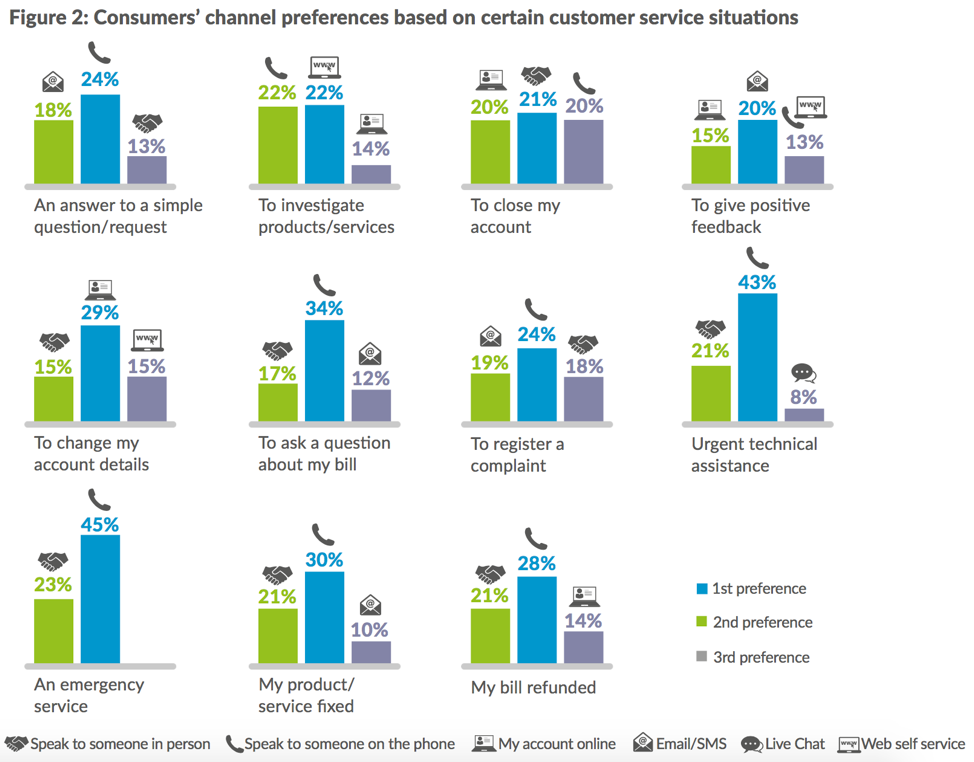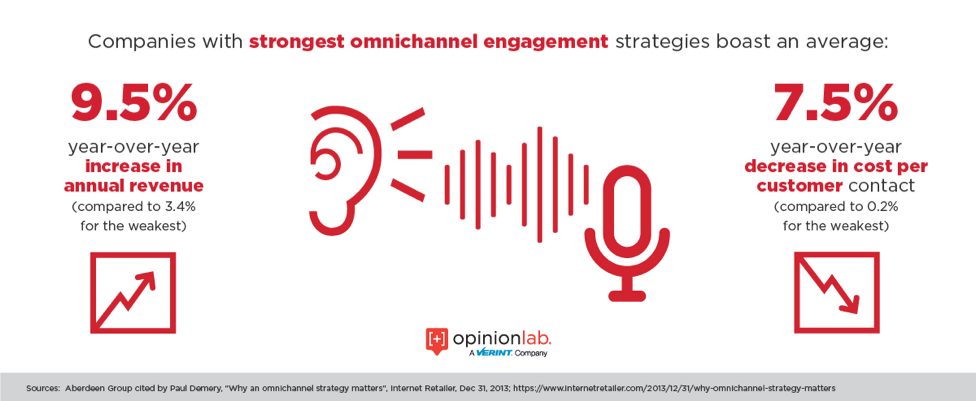“Omnichannel” has been a buzz word in CX circles for a while now. Which makes complete sense. Whereas before you were in control, your customers now want to engage with you on their terms whenever and however they want.
And this occurs across every contact point – be this online via your desktop or mobile site, through your mobile app, via live chat, one-to-one at your call center or even face-to-face in one of your physical locations.
If you’re able to excel in meeting this huge challenge head on, then the potential rewards on offer are huge.
But you need to tie every part of your omnichannel strategy to your own specific business objectives. Just because something works for another company, it doesn’t mean it’ll also work for you.
Effective omnichannel strategies drive results
It’s pretty simple: Research proves that a superior omnichannel experience positively impacts revenue. An inferior omnichannel experience has the opposite effect.

Aberdeen, in its omnichannel research, has claimed that businesses that adopt an omnichannel strategy achieve a 91% greater year-over-year increase in customer retention compared to those that don’t.
So how can you generate an omnichannel experience that ties all the different CX components in a way that is rewarding and impacts your bottom line?
Omnichannel experiences aren’t seamless enough
According to Google, 49% of people email themselves a link for continuing an activity on another channel or screen. What does this tell us? Experiences are not fulfilling enough in some digital formats to enable your customers to achieve what they want. Clearly, there’s no reason why your customers shouldn’t feel 100% comfortable completing a task in the same format they started it in.
The below chart from IDC illustrates similar issues – highlighting that a consistent experience is both one of the main keys and challenges to delivering a great customer experience. Not just omnichannel in an end to itself, but CX period.

But – whatever you do – it’s impossible to be everything to everyone. Different people have different digital consumption preferences and – while you can try – you may not be able to influence these as much as you’d like. In any case, a customer going to such lengths to remain engaged in your experience suggests strong brand loyalty.
Where you can probably do a better job is facilitating these transitions between channels. If customers want to switch from desktop to mobile, for example, make it easy for them. How many customers aren’t prepared to email themselves? Then think about the $ impact of that on your bottom line.
Personalization is key
Customers are becoming more and more accustomed to personalization. In fact, they are now at a stage where they are not only no longer freaked out by it but they instead demand it.
The data below – from our own survey – really highlights this point.

Analysis on outbound email performance also supports this point of view. Click rates for personalized emails are 241% higher than for standard emails.
So what does this say about how you need to adapt your customer experience? Personalization is key.
But how are you going to do this? You likely capture a wide range of customer data. You need to use this to your advantage.
Aberdeen identified key differentiators of top performing companies in omnichannel CX as:
- 60% more likely to utilize customer data to maintain the context of prior interactions
- 29% more likely to regularly train their reps to effectively use customer data to ensure consistency of messages delivered across channels.
Harness the information you already have to create more customized experiences. But make sure you fully understand the specific business impact of each personalization change you make. That way, you can adapt your approach in a way that best affects the broader objectives you’re trying to achieve.
Optimize each and every channel
Many CX teams focus on some channels at the expense of others. In doing so, they either consciously or sub-consciously attempt to influence customer behavior.
But the big problem with this approach is that your customers are human beings. They want to be able to engage with you how and when they want, switching channels as they go.
Recommended for You
Webcast, January 24th: Cold Email That Converts: Why Message-Persona Fit is the Key to Success
In other words, they have their own unique preferences and you need to adapt accordingly.
The infographic below – also from our own survey – tries to get to grips with this from a service situation perspective.

Bottom line: different service situations result in different channel communication preferences.
In the same survey, we also looked to analyze channel preference according to generational background.

Overall, these charts tell you that you can’t predict and shouldn’t try to influence customer behavior. The real answer is to cover every base by optimizing across all channels.
However, you should also tie any channel optimization action you take to business results. Does an increase in customer satisfaction with your call center result in increased revenue? Does improved in-store performance lead to a boost in sales? What about improvements to your website: do they have the same impact?
Make sure you factor this business result-driven analysis into any CX investment decisions.
Don’t neglect power of human interaction
With all that being said, your omnichannel strategy should always incorporate a human element (in addition to digital channels). The infographic below from the same survey referenced above highlights some more specifics around this point.

So, according to our survey, around 4 in 5 want direct person contact, 3 in 4 expect a phone number on your website and more than 6 in 10 think they get better service in-person.
This is completely understandable. After all, it’s hard to be thrilled with a positive self-service outcome. But an in-person interaction in which effort to please is obvious is genuinely enriching.
However, you need to tie this engagement back to business results. Are they leading to sales? Are they making your customers more loyal? How much do they cost you as a business? You certainly need to provide in-person interaction opportunities for your customers. But you need to do so in a thoughtful manner underpinned by your overarching business objectives.
Conclusion
A consistent and rewarding omnichannel customer experience is critical if you want to win in today’s highly competitive and challenging environment.
This is because omnichannel CX drives imperative broader business metrics, such as customer loyalty and business revenue.
There are a number of strategies key to optimizing omnichannel experiences.
Firstly, cross-channel personalization is now a proven approach to improve performance. So aim to personalize as much as possible.
Secondly, it almost goes without saying that you should optimize CX across each and every channel. As much as you’d like to, you can’t force your customers to interact with you how you’d like them to. You therefore need to respond to their preferences.
Thirdly, human interaction will always be important. Digital provides many benefits but sometimes your customers just want to talk to another person. So make sure you incorporate this into your overall approach.
With all this being said, any action you take to optimize omnichannel customer experience needs to be closely linked to your overarching business goals.
You should always be asking yourself: will this change have a direct measurable impact on these objectives?
Only then can you be sure you’re on the path to delivering exceptional omnichannel CX that has the business-defining effect you’re seeking.
